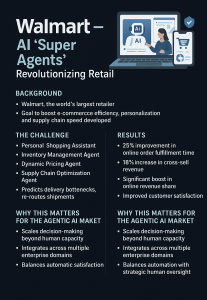Walmart, the world’s largest retailer, has been on a digital transformation journey for over a decade. While e-commerce sales were steadily growing, competition from Amazon and other online-first giants pushed Walmart to explore autonomous AI solutions to boost efficiency, personalization, and supply chain speed.
By 2024–2025, Walmart’s innovation labs began experimenting with agentic AI—AI agents capable of independently executing multi-step tasks under the codename “Project Sparky.”
The Challenge
Walmart faced three core operational challenges:
-
E-commerce Efficiency: Managing millions of SKUs, updating prices dynamically, and optimizing search recommendations without overwhelming human teams.
-
Omnichannel Personalization: Creating consistent shopping experiences across in-store, mobile, and online platforms.
-
Supply Chain Complexity: Reducing delays in inventory replenishment and improving demand forecasting for fast-moving products.

The Solution – AI “Super Agents”
Walmart deployed an ecosystem of AI agents—nicknamed “super agents”—that work both behind the scenes and in customer-facing channels.
Key capabilities included:
-
Personal Shopping Assistant: A customer-facing AI agent embedded in Walmart’s app, capable of:
-
Taking voice or text orders (“Find me healthy snacks for under $10”)
-
Suggesting complementary products
-
Comparing prices across Walmart’s inventory instantly
-
-
Inventory Management Agent: Monitors real-time sales, warehouse capacity, and supplier lead times, then autonomously initiates reorders.
-
Dynamic Pricing Agent: Continuously adjusts prices based on demand, competitor activity, and inventory levels.
-
Supply Chain Optimization Agent: Predicts delivery bottlenecks before they occur and re-routes shipments proactively.
Implementation Strategy
-
Multi-Agent Coordination: Agents communicate via a central orchestration layer, ensuring smooth hand-offs between supply chain, pricing, and customer service functions.
-
Cloud-Native Architecture: Walmart leveraged its hybrid cloud setup to enable real-time decision-making.
-
Human-in-the-Loop Safeguards: For high-impact decisions—like massive price changes or large-scale reorders—human managers still approve final execution.
Results
Within the first 12 months of deployment:
-
25% improvement in average online order fulfillment time.
-
18% increase in cross-sell revenue from personalized recommendations.
-
Significant boost in online revenue share—pushing Walmart closer to its goal of generating 50% of total revenue from e-commerce within 5 years.
-
Improved customer satisfaction scores, especially for mobile and app-based orders.
Why This Matters for the Agentic AI Market
This case highlights how agentic AI:
-
Scales decision-making far beyond human capacity.
-
Integrates across multiple enterprise domains—customer service, inventory, supply chain—without siloed operations.
-
Balances automation with strategic human oversight to maintain brand trust and operational stability.